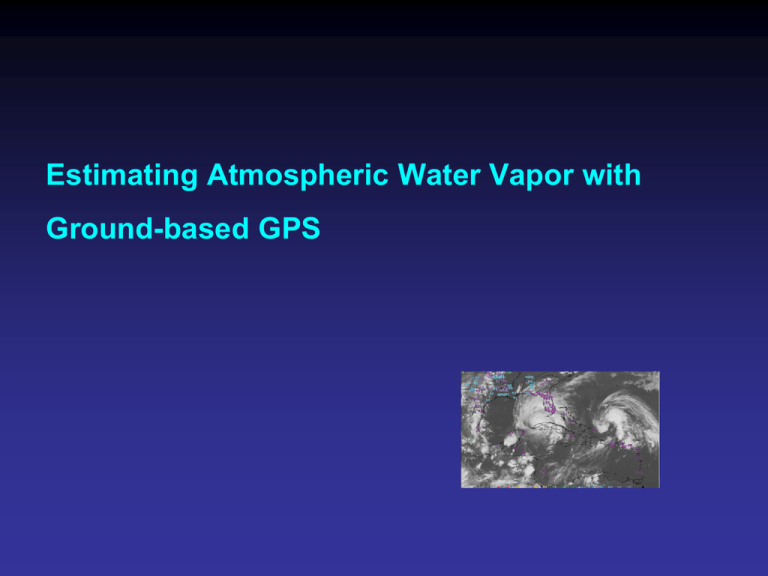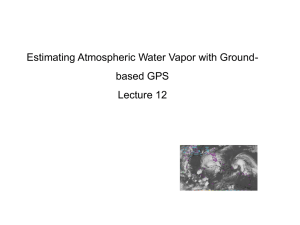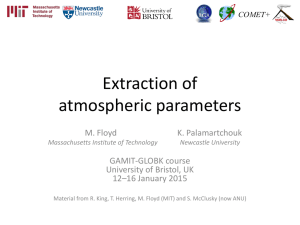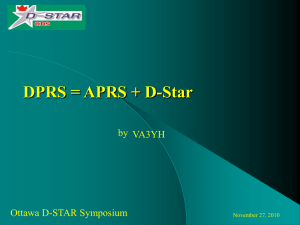GPS - GeoWeb
advertisement

Estimating Atmospheric Water Vapor with Ground-based GPS Sensing the Atmosphere with Ground-based GPS The signal from each GPS satellite is delayed by an amount dependent on the pressure and humidity and its elevation above the horizon. We invert the measurements to estimate the average delay at the zenith (green bar). ( Figure courtesy of COSMIC Program ) Multipath and Water Vapor Effects in the Observations One-way (undifferenced) LC phase residuals projected onto the sky in 4-hr snapshots. Spatially repeatable noise is multipath; time-varying noise is water vapor. Red is satellite track. Yellow and green positive and negative residuals purely for visual effect. Red bar is scale (10 mm). Sensing the Atmosphere with Ground-based GPS Colors are for different satellites Total delay is ~2.5 meters Variability mostly caused by wet component. Wet delay is ~0.2 meters Obtained by subtracting the hydrostatic (dry) delay. Hydrostatic delay is ~2.2 meters; little variability between satellites or over time; well calibrated by surface pressure. Plot courtesy of J. Braun, UCAR GPS adjustments to atmospheric zenith delay for 29 June, 2003; southern Vancouver Island (ALBH) and northern coastal California (ALEN). Estimates at 2-hr intervals. Effect of Neutral Atmosphere on GPS Measurements Slant delay = (Zenith Hydrostatic Delay) * (“Dry” Mapping Function) + (Zenith Wet Delay) * (Wet Mapping Function) • ZHD well modeled by pressure (local sensors or numerical weather model) • Analytical mapping functions (GMF) work well to 10 degrees • ZWD cannot be modeled with local temperature and humidity - must estimate using the wet mapping function as partial derivatives • Because the wet and dry mapping functions are different, errors in ZHD can cause errors in estimating the wet delay (and hence total delay) . Percent difference (red) between hydrostatic and wet mapping functions for a high latitude (dav1) and midlatitude site (nlib). Blue shows percentage of observations at each elevation angle. From Tregoning and Herring [2006]. Effect of error in a priori ZHD Difference between a) surface pressure derived from “standard” sea level pressure and the mean surface pressure derived from the GPT model. b) station heights using the two sources of a priori pressure. c) Relation between a priori pressure differences and height differences. Elevation-dependent weighting was used in the GPS analysis with a minimum elevation angle of 7 deg. Differences in GPS estimates of ZTD at Algonquin, Ny Alessund, Wettzell and Westford computed using static or observed surface pressure to derive the a priori. Height differences will be about twice as large. (Elevationdependent weighting used). Example of GPS Water Vapor Time Series GOES IR satellite image of central US on left with location of GPS station shown as red star. Time series of temperature, dew point, wind speed, and accumulated rain shown in top right. GPS PW is shown in bottom right. Increase in PW of more than 20mm due to convective system shown in satellite image. Water Vapor as a Proxy for Pressure in Storm Prediction GPS stations (blue) and locations of hurricane landfalls J.Braun, UCAR Correlation (75%) between GPS-measured precipitable water and drop in surface pressure for stations within 200 km of landfall. EXTRA STORMS Atmospheric Delays Ionosphere (use dual frequency receivers) Troposphere (estimate troposphere) Influence of the Atmosphere Atmospheric and Ionospheric Effects • Precipitable Water Vapor (PWV) derived from GPS signal delays • Assimilation of PW into weather models improves forecasting for storm intensity • Total electron count (TEC) in Ionosphere 25 Suominet – PBO Stations • 80 Plate Boundary Observatory (PBO) sites now included in analysis. •These sites significantly improve moisture observations in western US. •Should be useful for spring/summer precipitation studies. •Network routine exceeds 300 stations. Impact of GPS PW on Hurricane Intensity Dean - 2007 Gustav - 2008











